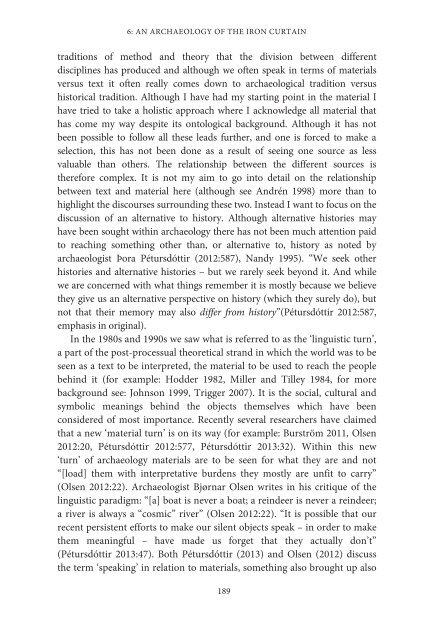1JZGauQ
1JZGauQ
1JZGauQ
Create successful ePaper yourself
Turn your PDF publications into a flip-book with our unique Google optimized e-Paper software.
6: AN ARCHAEOLOGY OF THE IRON CURTAIN<br />
traditions of method and theory that the division between different<br />
disciplines has produced and although we often speak in terms of materials<br />
versus text it often really comes down to archaeological tradition versus<br />
historical tradition. Although I have had my starting point in the material I<br />
have tried to take a holistic approach where I acknowledge all material that<br />
has come my way despite its ontological background. Although it has not<br />
been possible to follow all these leads further, and one is forced to make a<br />
selection, this has not been done as a result of seeing one source as less<br />
valuable than others. The relationship between the different sources is<br />
therefore complex. It is not my aim to go into detail on the relationship<br />
between text and material here (although see Andrén 1998) more than to<br />
highlight the discourses surrounding these two. Instead I want to focus on the<br />
discussion of an alternative to history. Although alternative histories may<br />
have been sought within archaeology there has not been much attention paid<br />
to reaching something other than, or alternative to, history as noted by<br />
archaeologist Þora Pétursdóttir (2012:587), Nandy 1995). “We seek other<br />
histories and alternative histories – but we rarely seek beyond it. And while<br />
we are concerned with what things remember it is mostly because we believe<br />
they give us an alternative perspective on history (which they surely do), but<br />
not that their memory may also differ from history”(Pétursdóttir 2012:587,<br />
emphasis in original).<br />
In the 1980s and 1990s we saw what is referred to as the ‘linguistic turn’,<br />
a part of the post-processual theoretical strand in which the world was to be<br />
seen as a text to be interpreted, the material to be used to reach the people<br />
behind it (for example: Hodder 1982, Miller and Tilley 1984, for more<br />
background see: Johnson 1999, Trigger 2007). It is the social, cultural and<br />
symbolic meanings behind the objects themselves which have been<br />
considered of most importance. Recently several researchers have claimed<br />
that a new ‘material turn’ is on its way (for example: Burström 2011, Olsen<br />
2012:20, Pétursdóttir 2012:577, Pétursdóttir 2013:32). Within this new<br />
‘turn’ of archaeology materials are to be seen for what they are and not<br />
“[load] them with interpretative burdens they mostly are unfit to carry”<br />
(Olsen 2012:22). Archaeologist Bjørnar Olsen writes in his critique of the<br />
linguistic paradigm: “[a] boat is never a boat; a reindeer is never a reindeer;<br />
a river is always a “cosmic” river” (Olsen 2012:22). “It is possible that our<br />
recent persistent efforts to make our silent objects speak – in order to make<br />
them meaningful – have made us forget that they actually don’t”<br />
(Pétursdóttir 2013:47). Both Pétursdóttir (2013) and Olsen (2012) discuss<br />
the term ‘speaking’ in relation to materials, something also brought up also<br />
189




